Do you want to know about your profits in Shopify? If so, this guide is going to help you know how to track shopify profits!
A critical assessment of your profits and losses is always essential for running any business. That's because they give you a clear understanding of where you stand in your business and where you need to improve.
Similarly, in Shopify Business, you do have to understand the various aspects of your Dropshipping business where you can check out business finance, expenses, cash inflow and outflow. Even you have to be keen on managing your inventory levels so that you can profitably run your Shopify business.
So in this post, we will discuss why Profit tracking of your Shopify Business is important and also guide you about how you can track it.
Why is it important to track Shopify profit?
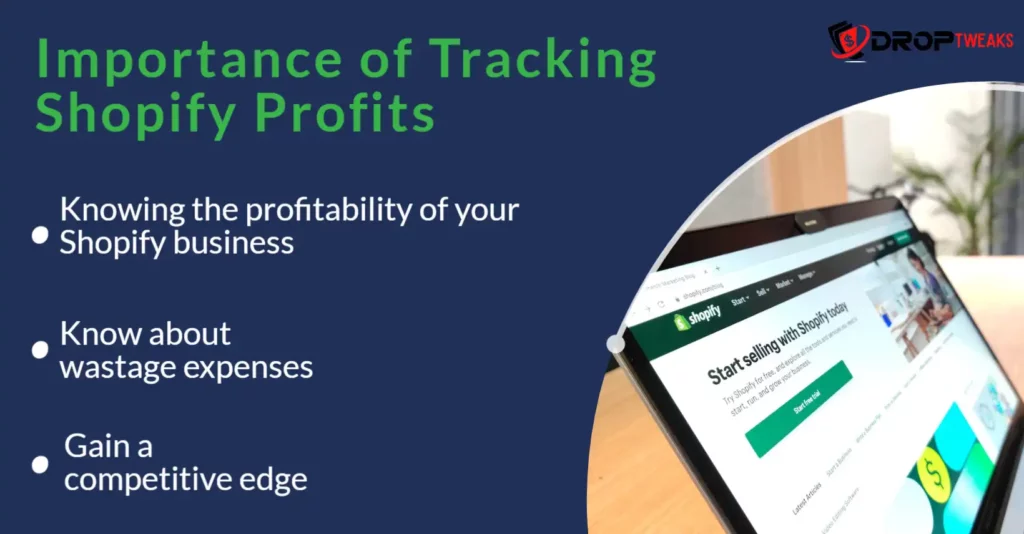
Following are a few reasons that explains us why is it important to track Shopify profit.
#1 Knowing the profitability of your Shopify business
As in the case of any business, checking our profitability is going to let you get aware of how you are running your business and also what things you can change to increase your profit. Though some people might only say that the profit formula is simple, where you subtract the expenses from income, that will not let you know the other key parameters to improve upon.
So to know more about and to have a dynamic approach towards your Shopify Business, you can take the help of profit-tracking apps, which are going to help you understand various key aspects of your business which we are also going to talk about, later in the article.
#2 Know about wastage expenses
Few business expenses can be avoided as they are no longer required. You can know about them when you track profit. Similarly, in Dropshipping with Shopify, few expenses can be curtailed. Still, for that, you have to track Shopify profits and have a clear understanding of such kinds of costs, which excluded can increase the profitability of your Shopify Dropshipping Business. To find such unhealthy expenses, you have to do a deep dive into your profits to understand them and then decide how to avoid or curtail them.
#3 Gain a competitive edge
Shopify Business can be tough at times if you don't analyze the profits properly. Along with this, when you analyze the profits well, it can help you to understand the business in a more comprehensive way and also give you an edge over your competitors.
This is important because by looking at the profits/losses, you can make an informed decision about how things go well in your business and note down the key prospectives to improve upon. Properly analyzing the profits and re-investing in them is going to maximize your business and help it grow better.
Step-by-step guide on how to track Shopify profits
Next, we are going to discuss how you can track your profits using various ways right from the Shopify dashboard itself. But first, you will have to know your product listings and enter your cost per item.
First things first, you get profit reports in Shopify through which you can check out profits. But for that, you need to be on the Shopify plan or higher.
Following are the Steps that are taken by Shopify itself.
Shopify will only show you the profits of those products and variants of which costs have been recorded timely that were sold. And for this, you need to add value to your profit reports, for which you have to add a cost per item relative to those products.
Following steps you need to follow:
- Step 1 – Open the Shopify Admin and click on Products.
- Step 2 – Now click on the name of a product to edit it.
- Step 3 – In the pricing section, you will have to add the dollar value to the cost per item. This cost is how much the product or variant costs you.
- Step 4 – Hit the Save button.
- Only if your product has a variant then only you need to edit each variant to add the cost per item.
Checkout profit reports
- Step 1 – Click on the Shopify Admin and head to Analytics, and then to Reports.
- Step 2 – Click on Categories.
- Step 3 – Now click on the Profit Margin and you can filter those reports and check only the profit margin reports.
Next is where we will check out how to know the profit of a product through Profit Reports.
Knowing profit through profit reports
The Profit Report is going to show you exactly how much your profits are. But in the report, there are a few terminologies which you need to understand before assessing the profits.
First, the profits are only recorded for the products that have had cost recorded at the time they were sold. And that's among the significant reasons why you will find that there is an inconsistency between the net sales number shown in your sales and profit reports. So to get the accurate value in your profit reports, you have to add a cost per item to your products.
For each of the product cost are recorded, you will see the following information:
| Net Quantity | Total Number of Units sold during that period. |
| Net Sales | Total Net Sales during that period. |
| Costs | The Total Costs of the units sold during that period |
| Gross Margin | The Profit Margin for that product in that time period. It is calculated as ([net sales – cost] / net sales) * 100. |
| Gross Profit | This is the Total profit made on this product during this time period. It is calculated by subtracting the cost from net sales. |
Another aspect is that if you offered discounts and refunds on your products, this could create fluctuation in your Gross margin.
Knowing profit through product variant SKU
The Product variant SKU will show you gross profit by variant.
The Profits are recorded as per the variants of which the cost was recorded for that time interval. And because of this, you can notice a fluctuation in the net sales number shown in your sales and profit reports.
For each product variant of which costs is recorded, you will see the following information:
| Net Quantity | Total number of units sold in that time period. |
| Net Sales | Total Number of Sales during that time period. |
| Cost | Total Cost of the units sold during that time period. |
| Gross Margin | It is the profit margin on that product for that particular time period. It is calculated as ([net sales – cost] / net sales) * 100. |
| Gross Profit | It is the Total Profit made on the product for that time period. It is calculated by subtracting the cost from net sales. |
Knowing profit through point of sale location
The Point of Sale location will tell you about gross profit by point of sale location.
For each of the Point of Sale location, you can check out the following:
| Net Quantity | Total number of units sold in that time period. |
| Net Sales | Total Number of Sales during that time period. |
| Cost | Total Cost of the units sold during that time period. |
| Gross Margin | It is the profit margin on that product for that particular time period. It is calculated as ([net sales – cost] / net sales) * 100. |
| Gross Profit | It is the Total Profit made on the product for that time period. It is calculated by subtracting the cost from net sales. |
Refunds and discounts
As stated earlier, refunds and discounts affect to a great extinct on your profit margin.
The Margin that you see on the Product details page is based on the full price of the product. But the Gross Margin that you see profit reports undermines the net sales of the product, which takes into account the refunds and discounts offered by you during that particular time period.
Few considerations if you want dynamic reporting
For Dynamic reporting, you will have to follow the the options mentioned below:
The Cost per Item data is about a particular time period. But if you want cumulative data that is dynamic, you have the following options:
- You will have to ensure that you run a proper analysis of your financial reports on other business systems like enterprise resource planning (ERP) or Accounting systems.
- You can consider using a reporting app from the Shopify App store to check out the total value of your inventory.
- You can also calculate profits, costs and losses manually.
Now, that was all for the manual part. Next, we will check out the Top Apps through which you can calculate & track Shopify profits.
6 best apps to track Shopify profits
#1 BeProfit
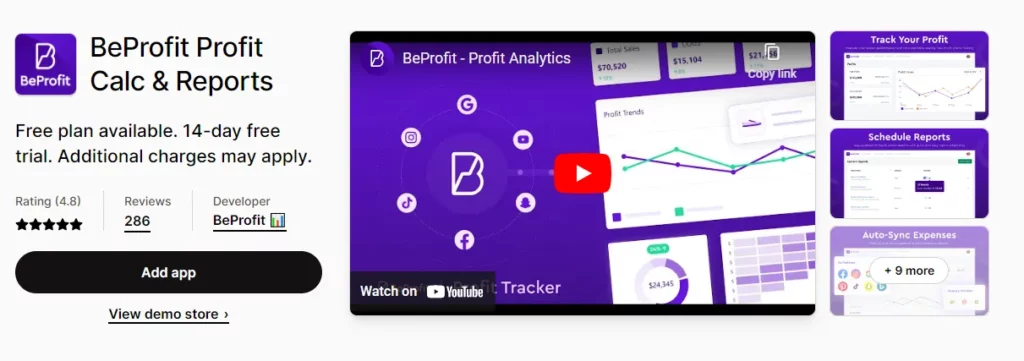
First on our list is the BeProfit App which is a widely recognized app to track Shopify profits. This App is known to offer key insights on various parameters and allows you to understand your business performance through which you can track your profits effectively and more precisely.
The App also gets integrated with other apps like Google Analytics, Facebook, Shipstation, etc., in Shopify to deliver you the best and most accurate profit reports. Along with this, this App has an easy-to-use and intuitive dashboard that allows you to perform a detailed and precise analytic report for your business performance over a period of time.
This app is a valuable one where you can track and even optimize other key business metrics like marketing, custom reports, and lifetime profit, along with others that can help you to calculate and make better-informed decisions for your business.
The tool will monitor sales, costs, and profits in real-time and comes with essential features like schedule reports, Product reports, LTV cohort analysis and more to help you know your profit reports.
The BeProfit App comes with a Free Plan for up to 30 monthly orders, which is excellent as you can know about the various features of this App before choosing any of its paid plans. Its pricing plans start from $25/month and go up to $150/month.
#2 TrueProfit
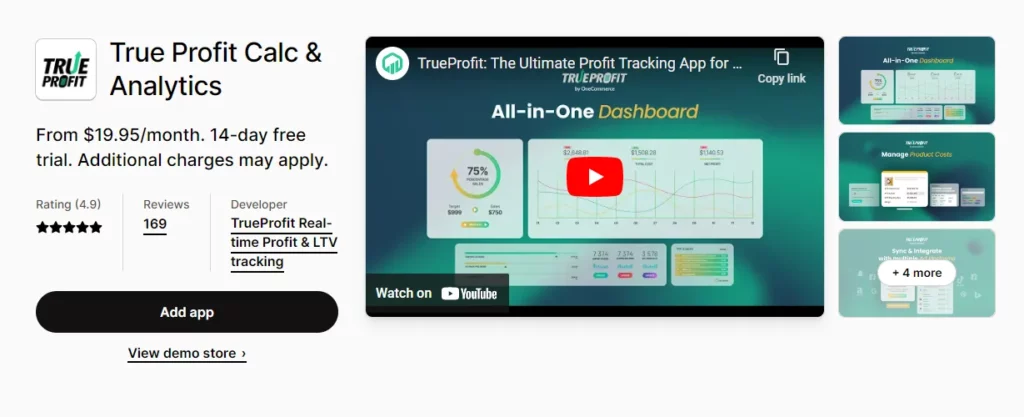
Second on our list of Best best profit-tracking apps for Shopify is the True profit calculator, which is a product of One Commerce.
This App comes you with all the key information about all costs and profits in real time. You can also set this all in auto-pilot mode, as the App offers you this feature right from the dashboard, which is easy to use.
It allows you to monitor and track your customer lifetime value and other critical aspects through which you can find your total gains. Some of the key features offered by it are Transaction, Handling, Custom costs, and Auto-track Profit. Ad metrics (Revenue & ROAS) on Facebook, TikTok, Google, Bing, Snapchat & Pinterest and more!
The app comes for both iOS and Android and integrates with major ad platforms and Google Analytics, plus also offers excellent customer support as well.
About its pricing, well, its initial plan costs $19.95/month and goes up to $39/month.
#3 SimplyCost
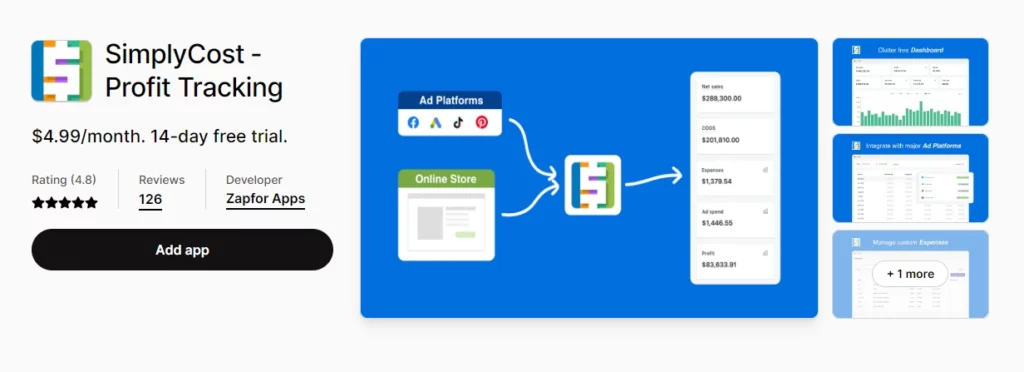
SimplyCost is another app through which can help you track shopify profit. It offers powerful tools for this through which you can have an accurate break-down of your sales, expenses, and profit margins to get a precise estimate of your profits.
Along with helping you with tracking profit and calculating transaction fees, this app also provides you key reports on sales, profits, inventory, products that sell more and also which platforms bring in the most conversions.
This SimplyCosts app will allow you to know about your sales better, through which you can make better-informed decisions for your business. A few key features offered by this app are Automatic profit calculation, Payment gateway processing fees and more!
Plus, the app is also known to integrate well with top ad platforms like Facebook, TikTok, and even Google Ads. Moreover, the tool comes in with a 14-day Free Trial and comes with only one plan, which costs $4.99/month.
#4 Lifetimely: LTV & Profit

Lifetimely is a popular Shopify profit-tracking app through which you can track and calculate various KPIs of your business. It allows you to analyze and report profits through which you can have proper assessments of your profit.
This profit tracking app has an easy-to-use dashboard that provides AI-based LTV projections which predict the spending capability of your customers every month. It has 8+ LTV metrics to measure your customer value. Now that's a key feature that you don't find in any profit-tracking apps of Shopify, which can give you a competitive edge, and you can know more about customer behaviors and their spending patterns.
The tool also offers filters like the first-order product, marketing channel etc., through which you can know what's driving customers. It also comes with a CAC payback tool through which you can calculate ad spend break-even points.
Lifetimely app comes with a 14-Day Free Trial along with a Free Plan, which is great. Taking about its pricing, the initial plan costs just $19/month and goes up to $99/month.
#5 Profitario
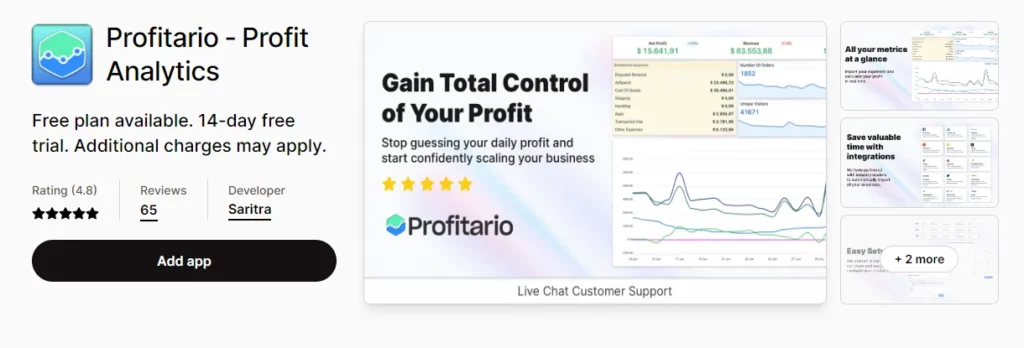
Are you looking to track your finances and profit? Profitario is a fantastic app that can help you do that exactly. Through this app, you can check out profit margins and disputes. You can also automatically import this information into an easy report which you can analyze later.
It allows you to view marketing cost, cost of goods sold, revenues, and return through which you can properly assess the business and know more about key parameters that affect your business. You can also monitor your profit margin in real-time and get access to valuable reports which are going to display information. The tool even offers a few data-entry tools which aid in inventory management.
You can also use this app as an integration with many other apps to boost your workflow management. Profitario comes with a Free plan for up to 100 monthly orders. Its basic plan costs $20/month, and the professional plan costs $50/month.
Top FAQs on how do you track Shopify profits in 2024
How to check your profit on Shopify?
You can check out the Profit on Shopify by heading to Shopify Admin and then going to Analytics > Reports. After that, select the Categories and Click on profit margin, through which you can filter the reports to view only profit margin reports.
How does Shopify calculate gross profit?
Shopify calculates Gross Profit by subtracting the cost of goods sold (COGS) from the gross sales.
How does Shopify calculate the total sales?
Shopify calculates Total Sales by subtracting the returns and discounts from the gross sales, and then it adds the returns, taxes and shipping charges.
How does Shopify calculate the gross margin?
Shopify calculates the gross margin by subtracting the cost of goods sold (COGS) from the gross sale. After this, it divides it from the gross sales and then multiplies it by 100.
Succinct: How can you boost and track Shopify profit?
Consider any business, for that matter; properly assessing the profit and losses is something that is always going to be a key for any successful business. And if you have a Shopify Business, it becomes even more critical to track profits as by doing so, you can check out whether things are going according to your wish or if you need a few improvements.
And to help you with that, we have also provided you our Top 6 Best Apps to Track Profits in Shopify, which can help you to completely automate this task, thereby which you can concentrate on other important tasks, which also increases your productivity. You can also take the help of the Shopify dashboard, which does provide you a good amount of data to access your profits and grow your business.
